How to Adjust a Toilet Float and Fill Valve Fast!
Last Updated on August 8, 2023 by toilethaven
What is a Toilet Float?
A toilet float is the toilet tank part connected to the fill valve. It regulates the opening and closing of the fill valve and, therefore, the water level in the toilet tank.
The fill valve, on the other hand, is the toilet tank part that is responsible for filling the tank after each flush. Your toilet will have a float ball valve, float cup valve, or, most recently, an internal float valve.
When the float valve is not adjusted correctly, the water level in the tank will either be too high or too low.
If the water level in the tank is too high, it will start to flow down to the bowl via the overflow tube resulting in a running toilet. The low water level in the tank will result in a weak flush as the toilet will not have the necessary force.
Ideally, the water level in the tank should be about 1/2-1 inch below the overflow tube. If the water level is below or above that level, you will need to adjust the toilet float.
To appreciate and comprehend this, let us look at how a toilet works through the different toilet tank parts.
How a Toilet Works.
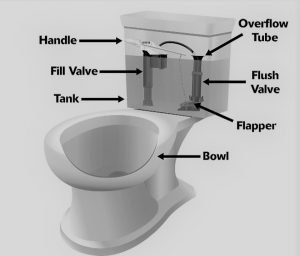
- When you pull the toilet handle, a chain inside the toilet tank lifts off the toilet flapper from the flush valve opening. The toilet flapper is the seal at the bottom of the tank, which seals off the flush valve. The flush valve is the opening through which water flows from the tank to the bowl.
- When the flapper lifts off, water flows out through the flush valve for flushing to happen in the bowl.
- After the water has left the tank, the flapper falls back into position and seals off the flush valve.
- Prior to you pulling the flushing handle, the toilet float was floating at the top of the tank. After flushing and the tank is empty, the toilet float falls to the bottom of the tank, a move which opens the fill valve.
- The fill valve is connected to the water supply line from the bottom of the tank. It starts filling the tank.
- As the fill valve fills the tank, the toilet float floats on top of the water and moves up gradually.
- When the toilet float reaches its set height, it stops moving and shuts off the fill valve.
- There is a thin tube called the refill tube, which is connected to the fill valve and clipped on the overflow tube.
- As the fill valve fills the tank, the refill tube sends down a small amount of water to the bowl. This is the water you see at the bottom of the bowl. It creates a barrier preventing foul sewage odors from coming up to the bathroom. If the toilet float is not well adjusted and the fill valve puts less water in the tank, the water level in the toilet bowl will also be low. Adjusting the toilet float will also help raise the water in the toilet bowl.
- The overflow tube is the large tube in the middle of the tank connected to the flush valve. It prevents overflowing of the toilet by sending excess water in the tank down to the bowl.
Types of Toilet Floats
Your toilet tank will have one of these toilet floats. They all work the way, just that there have been improvements over the years.
1. Float Ball
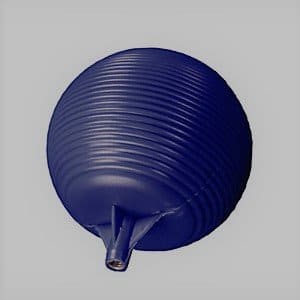
Float balls are mostly installed in old toilet models and have existed for a long time. They consist of a round plastic ball connected to the fill valve via a float arm. A float ball is also called a ballcock.
If you notice that it’s not floating at all while adjusting the float ball, check if there is water inside the ball. The float ball should be empty at all times. If it contains water, it will need to be replaced.
2. Float Cup
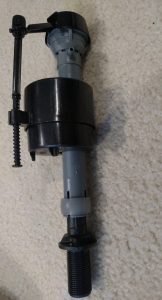
A float cup is also called a float cylinder. It is relatively smaller than a float ball. Float cups are installed on the vertical body of the fill valve. They are very popular with modern toilets since they can be used with single- and dual-flush toilets.
3. Internal Float
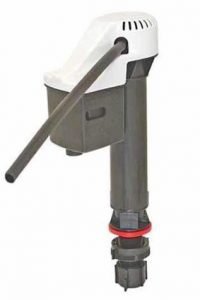
If your toilet refills noisily, then this is the toilet float you need to buy. This type of toilet float is relatively new and slightly improved than the float cup. The main advantage of installing one is that it refills slowly and has a more precise water shut-off.
When to Adjust Your Toilet Float
What are telltale signs that your toilet float needs to be adjusted? Here are a few of them:
1. When you have a running toilet
A running toilet is a very expensive problem to have. With every minute that passes, your money runs down the drain. Although not all running toilets are caused by a wrongly set float, the toilet float and fill valve are sometimes responsible.
To be sure what the problem is, lift off the tank lid and check the water level in the tank. If the water level is too high that water flows down through the overflow tube, you need to adjust the overflow tube.
Sometimes, the problem is caused by a defective fill valve continuously filling the tank. In this case, you will need to replace the fill valve. Meanwhile, you will need to turn off the water to the toilet to avoid more wastage. The toilet shut-off valve is on the wall behind the toilet.
2. Weak flushing toilet
A weak flushing toilet is very irritating. Having to flush a toilet twice is not anyone’s cup of coffee. This happens mostly when you don’t have enough water in the tank.
Again, remove the toilet tank lid and check the water level. If the water level is too low, you need to adjust the toilet float to raise the water.
3. Water level in the bowl is too low
Your toilet bowl needs to retain a certain water level at the bottom. If the water level in the bowl is lower than the waterline, the fill valve is not filling the tank with enough water, and you will need to adjust the float.
4. Toilet tank is taking too long to refill
If your toilet tank is refilling slowly, it points out to a faulty fill valve which mineral deposits could block. In this case, you might want to replace the fill valve or try and remove the mineral deposits.
How to Adjust a Toilet Float and Fill Valve
Adjusting a toilet float is a very simple task that every homeowner should be able to do comfortably. You will only need a screwdriver to do this repair.
While adjusting the toilet float, you want to make sure the water level is about an inch below the overflow tube. Some toilet tanks are marked, so you need to bring the water level to that mark.
1. How to Adjust a Float Ball/Ballcock
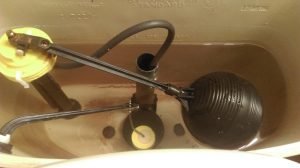
- Remove the tank lid and place it away in a safe place.
- Look for a screw where the float arm is connected to the fill valve.
- Using the screwdriver, turn the screw clockwise to lower the water level in the tank and counterclockwise to raise the water level in the tank.
There is another way to adjust a float ball which is not ideal since you cannot accurately set the water level. These are:
- Bending the float arm upwards to increase the water level.
- Bending the float arm downwards to lower the water level.
2. How to Adjust a Float Cup
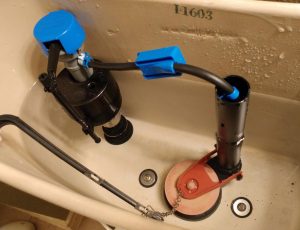
People often ask, “How do you fix a running toilet without a ball float”? A toilet without a ball float is mostly installed with a float cup valve. This is how to adjust a float cup:
- Look for a long plastic adjustment screw alongside the body of the float.
- With the screwdriver, turn the screw clockwise to lower the water level and counterclockwise to raise the water level in the tank.
- If your float does not have an adjustment screw, reach down to the shank of the fill valve and get hold of the release clip. Move the clip up and down to raise and lower the water level respectively.
3. How to Adjust an Internal Float

- Unclip the refill tube from the overflow tube.
- Rotate the float 1/8 and turn counterclockwise to unlock it.
- Move it up or down to raise or lower the water level.
- Turn it 1/8 clockwise to lock it in place.
- Clip the refill tube on the overflow tube.
Toilet Float Replacement
Toilet floats are sold hand in hand with the fill valve. A brand new toilet fill valve and float cost about 20 dollars. For a detailed post on replacing a toilet fill valve and float, check out this post.